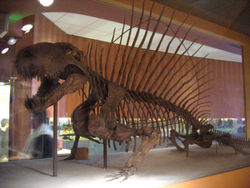Pelycosaur
2007 Schools Wikipedia Selection. Related subjects: Dinosaurs
| iPelycosaurs |
||||||||||
|---|---|---|---|---|---|---|---|---|---|---|
 Dimetrodon grandis skeleton at the
National Museum of Natural History |
||||||||||
|
|
||||||||||
|
Extinct (fossil)
|
||||||||||
| Scientific classification | ||||||||||
|
||||||||||
|
|
||||||||||
|
Caseasauria
Eupelycosauria
|
The pelycosaurs (from Greek pelyx meaning 'bowl' and sauros meaning 'lizard') were smallish to large (up to 3 meters or more) primitive Late Paleozoic synapsid amniotes. They appeared during the Late Carboniferous and reached their acme in the early part of the Permian Period, remaining the dominant land animals for many millions of years. A few stragglers continued into the late Permian.
At least two pelycosaur clades independently evolved a tall sail, consisting of elongated vertebral spines: the edaphosaurids and the sphenacodontids. In life, this would have been covered by skin, and possibly functioned as a thermoregulatory device or for mating display. Pelycosaur fossils have been found mainly in Europe and North America, although some small, late-surviving forms are known from Russia and South Africa.
Well-known pelycosaurs include the genera Dimetrodon, Sphenacodon, Edaphosaurus, and Ophiacodon.
In 1940 the group was reviewed in detail and every species known at the time described (and many illustrated) in an important monograph by Alfred Sherwood Romer and Llewellyn Price.
Pelycosauria is a paraphyletic taxon because it excludes the therapsids. For that reason the term is not used in some modern books. Eupelycosauria is used to designate the clade that includes most Pelycosaurs along with the Therapsida and the Mammals. In contrast to "Pelycosaurs", this is monophyletic group. Caseasauria refers to a pelycosaur side-branch or clade that did not leave any descendents.
The pelycosaurs appear to have been a group of reptiles that had direct ancestral links with the mammalia, having differentiated teeth and a developing hard palate.
Taxonomy and Phylogeny
- Class Synapsida
- ORDER PELYCOSAURIA
- Suborder Caseasauria
- Family Eothyrididae
- Eothyris
- Family Caseidae
- Casea
- Cotylorhynchus
- Ennatosaurus
- Family Eothyrididae
- Suborder Eupelycosauria
- Family Varanopseidae
- Varanosaurus
- Mycterosaurus
- Mesenosaurus
- Varanops
- Family Ophiacodontidae
- Archaeothyris
- Ophiacodon
- Family Edaphosauridae
- Edaphosaurus
- Ianthasaurus
- Sphenacodontia
- Haptodus
- Palaeohatteria
- Pantelosaurus
- Cutleria
- Sphenacodontoidea
- Family Sphenacodontidae
- Ctenospondylus
- Dimetrodon
- Secodontosaurus
- Sphenacodon
- Tetraceratops
- ORDER THERAPSIDA
- Family Sphenacodontidae
- Family Varanopseidae
- Suborder Caseasauria
- ORDER PELYCOSAURIA